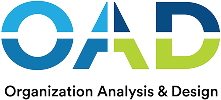Hiring the right people isn’t just a tactical decision—it’s a strategic advantage. In a competitive talent market, companies that make better hiring decisions consistently outperform those that rely on gut instinct or outdated processes. This guide outlines 10 proven strategies to help you attract, assess, and select the right candidates with confidence and clarity.
Table of Contents
- Why Better Hiring Decisions Are a Competitive Advantage
- The High Cost of Hiring the Wrong Person
- Strategy 1 – Start With a Clear, Behavioral Job Description
- Strategy 2 – Stop Relying on Resumes and Gut Instinct
- Strategy 3 – Use Objective Hiring Methods and Behavioral Data
- Strategy 4 – Design Structured Interviews That Reveal the “Right Person”
- Strategy 5 – Use Skills Challenges to Test Real-World Ability
- Strategy 6 – Prioritize Cultural Fit Without Sacrificing Diversity
- Strategy 7 – Build a Talent Pipeline Before You Need It
- Strategy 8 – Improve the Candidate Experience
- Strategy 9 – Don’t Neglect the Onboarding Process
- Strategy 10 – Track the Right Hiring Metrics
- Case Study: From Chaos to Clarity – A Mid-Market Company’s Turnaround
- Final Thoughts – Strategic Hiring Powers Growth
- Smarter Hiring Starts Here
Why Better Hiring Decisions Are a Competitive Advantage
Hiring isn’t just about filling roles—it’s about shaping the future of your organization. The quality of your hires directly impacts productivity, team morale, innovation, and ultimately, business outcomes. According to a study by the Society for Human Resource Management (SHRM), the average cost of a bad hire is as high as $240,000 when you factor in recruitment, training, lost productivity, and cultural disruption. This article is designed to provide comprehensive, research-backed guidance for making better hiring decisions.
Companies that treat hiring as a strategic function—not just an HR task—gain a measurable edge. They build stronger teams, reduce employee turnover, and drive sustained growth. In fact, research from McKinsey shows that organizations with high-performing talent practices outperform their peers by up to 2.2 times in revenue growth.
Better hiring decisions aren’t just about efficiency—they’re about long-term performance. When every hire aligns with your mission, values, and strategic goals, the entire organization moves faster and smarter.
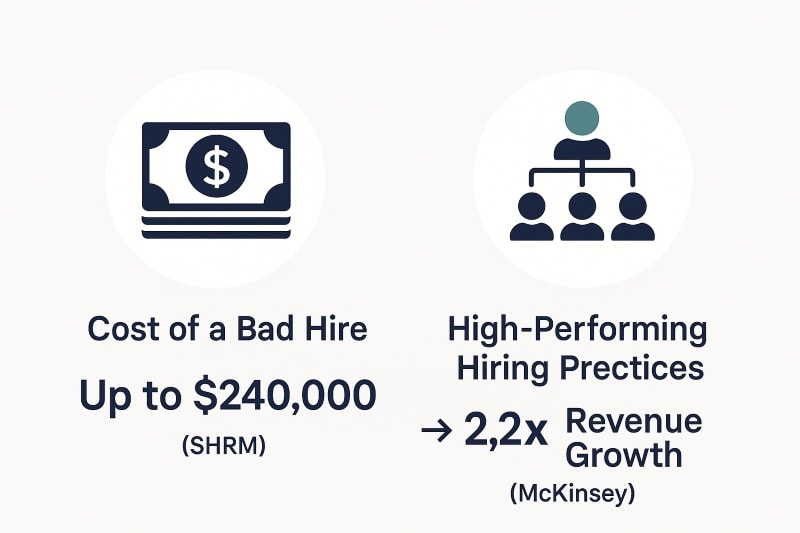
The High Cost of Hiring the Wrong Person
The consequences of a poor hiring decision ripple through every level of a business. It’s not just the direct costs—like recruitment fees, salary, and training—that impact your bottom line. It’s the indirect costs that sting the most: lost morale, team dysfunction, damaged client relationships, and missed business opportunities.
Howard Schultz, former CEO of Starbucks, once said, “Hiring people is an art, not a science—and resumes can’t tell you if someone’s values align with your company’s.” When you hire the wrong person, the misalignment can quietly drain performance and cultural cohesion over time.
According to a Gallup study, only 10% of employees possess the natural talent to manage others effectively—yet many companies promote or hire without any behavioral insight. This mismatch leads to disengagement and costly turnover. In fact, HBR reports that 80% of turnover is due to bad hiring decisions, not external factors. Understanding a candidate’s employment history and the reasons for leaving previous employment can help identify potential red flags and avoid costly hiring mistakes.
Worse, poor hires often result in “shadow costs” you can’t easily track: burnout among team members who pick up the slack, reputational damage when client experience suffers, and slowed innovation due to internal friction. Over time, these hidden losses can become a silent growth killer.
The good news? You can avoid most of these pitfalls with better hiring systems—and by focusing on alignment, not just qualifications.
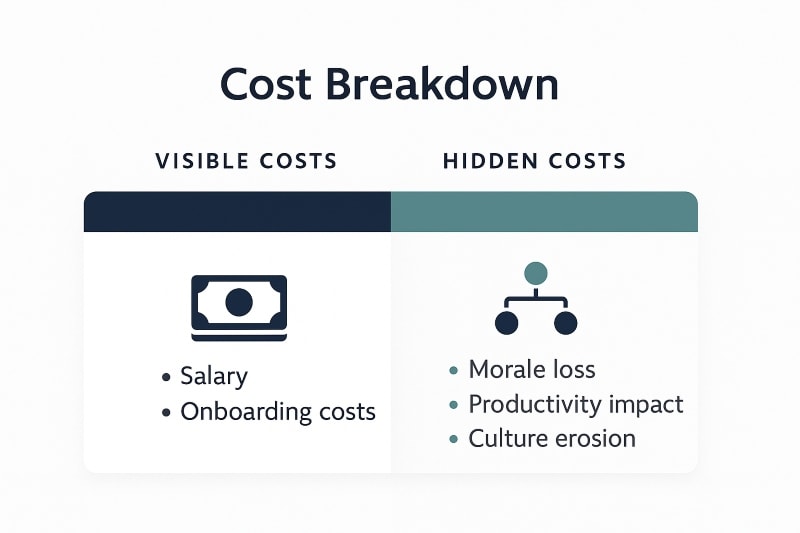
Strategy 1 – Start With a Clear, Behavioral Job Description
Most job descriptions are generic, vague, and focused on tasks. They list responsibilities and required experience—but they rarely describe the behaviors and traits a person needs to truly thrive in the role. That’s a problem. Understanding the specific requirements and context of different jobs is crucial for creating more effective behavioral job descriptions that truly reflect what success looks like in each position.
A clear, behavioral job description goes beyond “what” a person will do and defines how they need to do it. Will they need to think strategically under pressure? Collaborate across departments? Adapt to shifting priorities? These aren’t just bullet points—they’re behavioral expectations that should be baked into the role from the start.
Behavior-based descriptions help you attract the right candidates and repel mismatches before they apply. They also give hiring managers and interviewers a shared reference point for evaluating alignment throughout the interview process.
For example, a traditional description might say:
“Must be a team player with excellent communication skills.”
A behavioral version would say:
“Thrives in cross-functional teams, regularly initiates collaborative problem-solving, and provides clear, proactive updates to both technical and non-technical stakeholders.”
That level of clarity helps your team move from opinion-based hiring to evidence-based selection—and sets the foundation for better hiring decisions from day one.
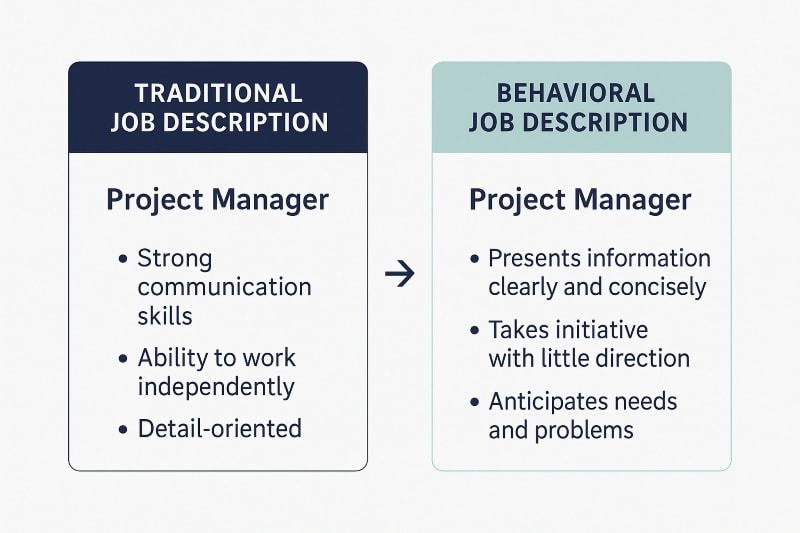
Strategy 2 – Stop Relying on Resumes and Gut Instinct
Resumes might tell you where someone worked—but they rarely tell you how they work. And relying on gut instinct? That’s often just bias in disguise.
According to a study published in the journal Personnel Psychology, traditional interviews and resume reviews are poor predictors of job performance. Why? Because past roles don’t reveal how a candidate thinks, adapts, or behaves under pressure—especially in environments different from their previous ones.
Even high-profile leaders caution against putting too much stock in resumes. Elon Musk famously said he doesn’t care if someone went to college at all, let alone a prestigious one. Traditional education is often overemphasized in hiring, yet focusing on behavioral traits can be far more predictive of success than academic credentials alone. What matters more is a candidate’s ability to solve problems and think critically.
The truth is, resumes create a false sense of security. A polished CV might mask red flags like rigid thinking, poor collaboration, or resistance to feedback. On the other hand, a less impressive resume might hide a high-potential performer who simply lacked the right opportunity—yet has exactly the behavioral traits your team needs.
Instead of filtering for experience alone, shift your attention to cognitive traits, motivation, decision-making style, and cultural alignment. That’s where behavioral assessments and structured processes—like those built into OAD’s platform—can remove the guesswork and surface true-fit candidates faster.
Strategy 3 – Use Objective Hiring Methods and Behavioral Data
If you want to consistently hire the right people, you need more than good intentions—you need objective data. That means replacing gut feelings and ad hoc interviews with validated tools that measure what really matters.
Structured interviews, psychometric assessments, and cognitive tests offer quantifiable insights into how a candidate thinks, works, and interacts with others. These tools help reduce bias, level the playing field, and reveal fit factors that traditional methods often miss. Well-developed interview frameworks, often created by human resources, are essential for ensuring a consistent and objective hiring process across different roles.
For example, structured interviews have been shown to be twice as effective as unstructured ones in predicting job performance (Source: Schmidt & Hunter, Psychological Bulletin). When paired with behavioral assessments, they create a clear, repeatable process that prioritizes alignment—not just charm or confidence.
This is where OAD’s approach shines. Our behavioral assessment measures core personality traits linked to workplace performance—like assertiveness, resilience, and attention to detail. The results provide hiring managers with a snapshot of how a candidate will likely behave in specific job scenarios, making it easier to compare applicants against role requirements.
The result? More confident hiring decisions, fewer costly mismatches, and stronger long-term team performance.
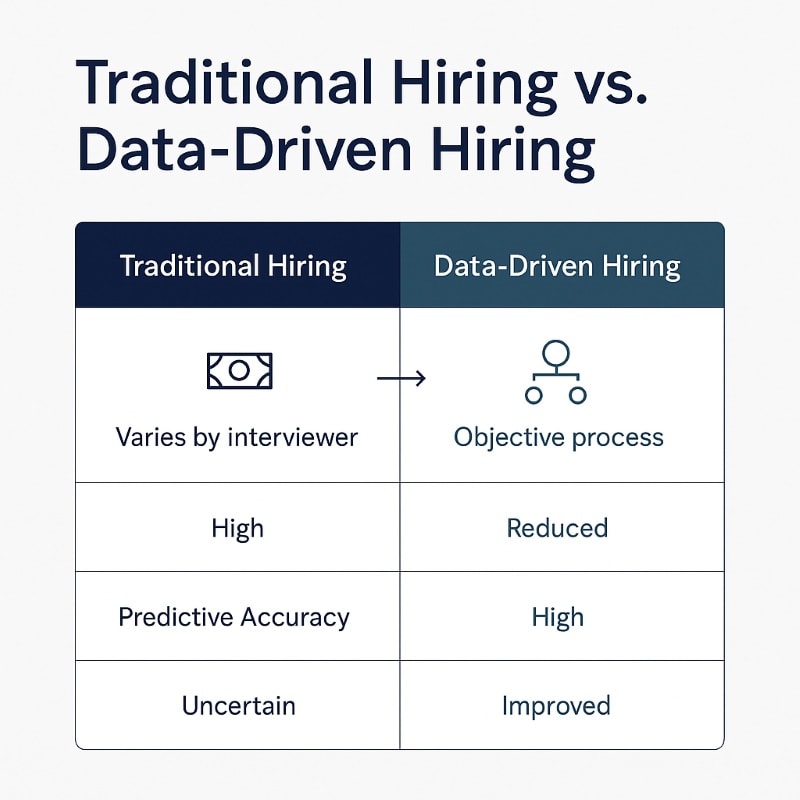
How to Reduce Bias in the Hiring Process
Let’s discuss the main points about bias in hiring and explore how organizations can address these challenges. Even the most well-intentioned hiring managers are vulnerable to bias. It’s human nature—we unconsciously favor people who look like us, think like us, or share our backgrounds. People tend to make decisions based on familiarity or first impressions, which can reinforce existing biases. But in hiring, bias leads to poor decisions, reduced diversity, and missed opportunities.
Common forms of hiring bias include:
- Affinity bias: Favoring candidates with similar hobbies, schools, or personalities
- Confirmation bias: Looking for evidence that supports your first impression
- Halo effect: Letting one positive trait overshadow everything else
These biases don’t just hurt fairness—they hurt business outcomes. Studies from Harvard and McKinsey show that diverse teams outperform homogeneous ones in innovation, problem-solving, and profitability.
So how do you reduce bias without making the process rigid?
- Use structured interviews and scoring systems
- Rely on data over “gut feel”
- Involve multiple interviewers with different perspectives
- Blind screen candidates in early stages (remove names, photos, etc.)
- Train hiring managers to recognize and mitigate bias
- Conduct reference checks to verify candidate information and gain objective insights, helping to reduce bias and avoid costly hiring mistakes
OAD assessments help reduce bias by offering objective behavioral insights that strip away surface-level impressions and focus on how candidates are likely to perform in your unique environment.
Reducing bias isn’t about removing the human element—it’s about improving it. By designing processes that mitigate instinctive errors, you build stronger, more inclusive teams.
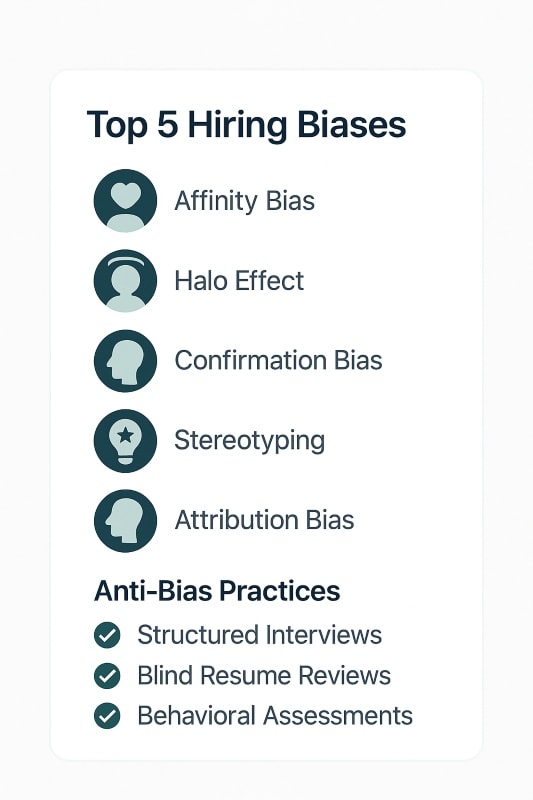
Strategy 4 – Design Structured Interviews That Reveal the “Right Person”
Unstructured interviews are like playing darts blindfolded—every once in a while, you hit the target, but most of the time, you’re just guessing. Structured interviews, on the other hand, give you a repeatable, bias-resistant process to identify the right candidate for the role.
In a structured interview, every candidate is asked the same set of role-specific questions, evaluated against a consistent scoring system. This method reduces subjectivity and helps hiring teams make decisions based on evidence—not charisma.
Consider Amazon’s famous Bar Raiser program, where specially trained interviewers focus on long-term cultural and performance fit, not just immediate role qualifications. Their process is structured, data-driven, and focused on raising the bar with every hire—something every company can adapt at their scale.
To implement your own version:
- Build a set of behavioral and situational interview questions tied to the job’s success traits
- Use rating sheets or scorecards to guide decision-making
- Ask interview questions in the same order to all candidates to ensure fairness and consistency in evaluations
- Include multiple interviewers to gain different perspectives, but ensure they follow the same criteria
When you involve multiple people in the interview process, you ensure a broader perspective and reduce individual bias, leading to more balanced hiring decisions.
This level of structure doesn’t just reduce bias—it builds confidence across your hiring team. And it sends a strong signal to candidates that your process is rigorous, fair, and intentional.
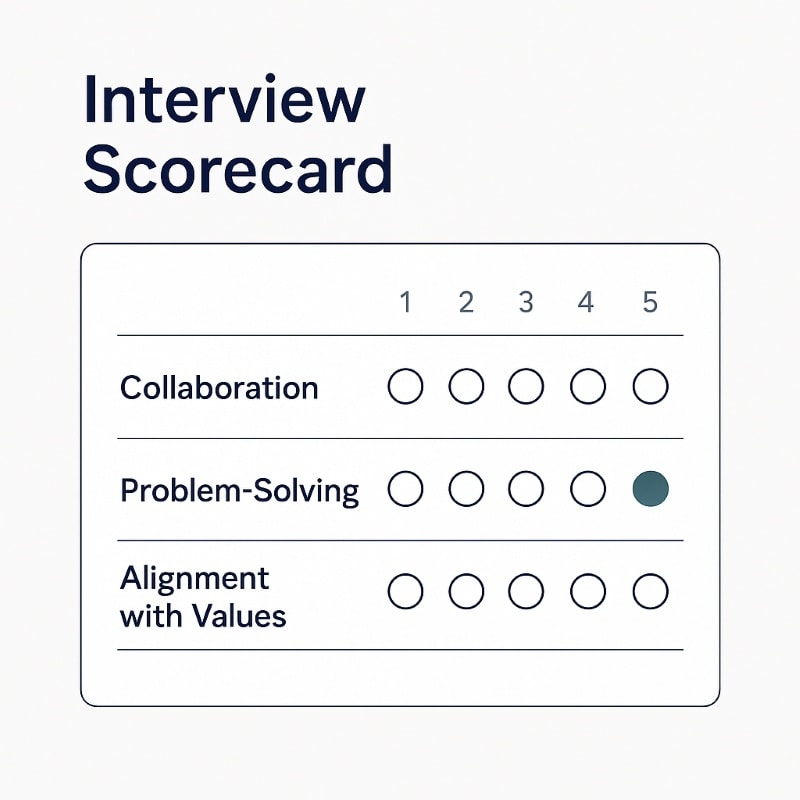
Empower Your Hiring Managers With Better Tools
Hiring managers often hold the final say in recruitment—but many have never been formally trained in how to hire effectively. They rely on intuition, past experience, or informal templates. The result? Inconsistency, bias, and missed alignment.
If you want to make better hiring decisions at scale, you need to equip your hiring managers with the right tools and frameworks—not just opinions.
Start with:
- Structured interview guides tailored to the role
- Clear success profiles outlining the behavioral traits needed to thrive
- Candidate scorecards to compare interview feedback objectively
- Access to behavioral data that goes beyond resumes or gut feel
The most effective hiring managers are not just evaluators—they’re collaborators in a strategic process. When they’re trained to use tools like OAD’s behavioral assessments, they gain a shared language to interpret candidate fit across personality, motivation, and potential. This doesn’t just speed up hiring—it elevates it.
Hiring is no longer just an HR function. It’s a core leadership skill. Equip your managers accordingly.
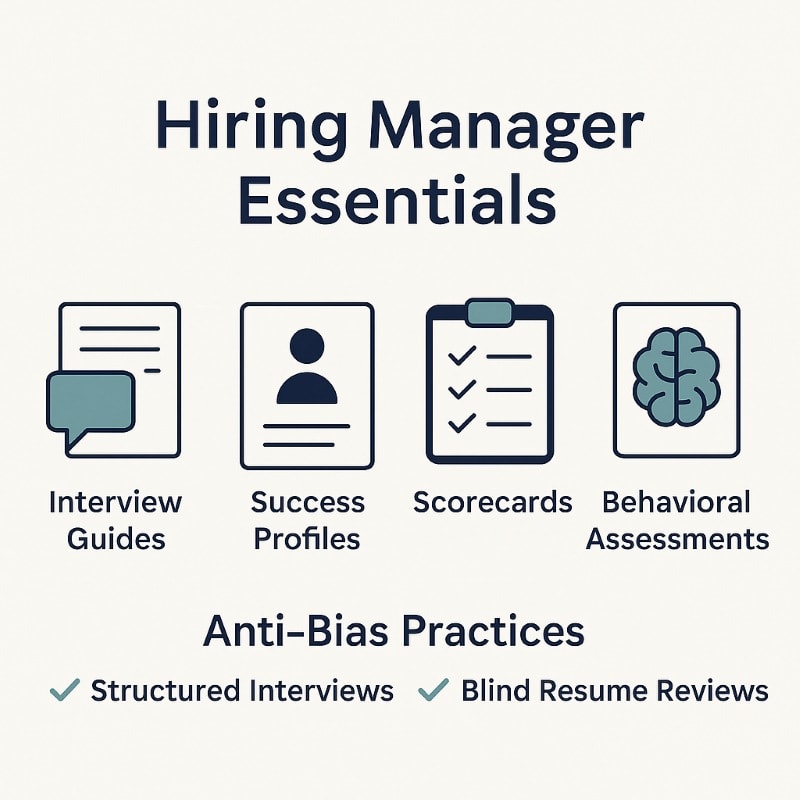
Strategy 5 – Use Skills Challenges to Test Real-World Ability
Would you hire a pilot based solely on their resume and a great interview? Probably not. Yet many companies do just that when hiring for complex roles—without ever testing how candidates perform in real scenarios.
A well-designed skills challenge gives you a window into real-world performance before making an offer. It doesn’t need to be complicated—a short assignment, case study, or simulation tied directly to the job is often enough to separate high-potential candidates from those who simply interview well.
These challenges aren’t just about confirming technical ability. They reveal:
- How a candidate thinks through problems
- How they communicate under pressure
- How they follow instructions—or challenge them strategically
- A candidate’s soft skills, such as communication, adaptability, teamwork, and leadership, which are often difficult to assess through traditional methods
And importantly, they help reduce bias. Instead of relying on perceptions or pedigree, you’re evaluating a candidate based on their ability to do the work. It’s a method used by leading companies like Atlassian, Google, and even NASA when hiring mission-critical talent.
To make the most of a skills challenge:
- Keep it relevant to the role and respectful of the candidate’s time
- Evaluate using a clear rubric aligned with job priorities
- Share the results with multiple reviewers to get balanced input
When used thoughtfully, this step can prevent costly hiring mistakes and surface unexpected high performers—people who might not have stood out on paper, but shine where it counts.
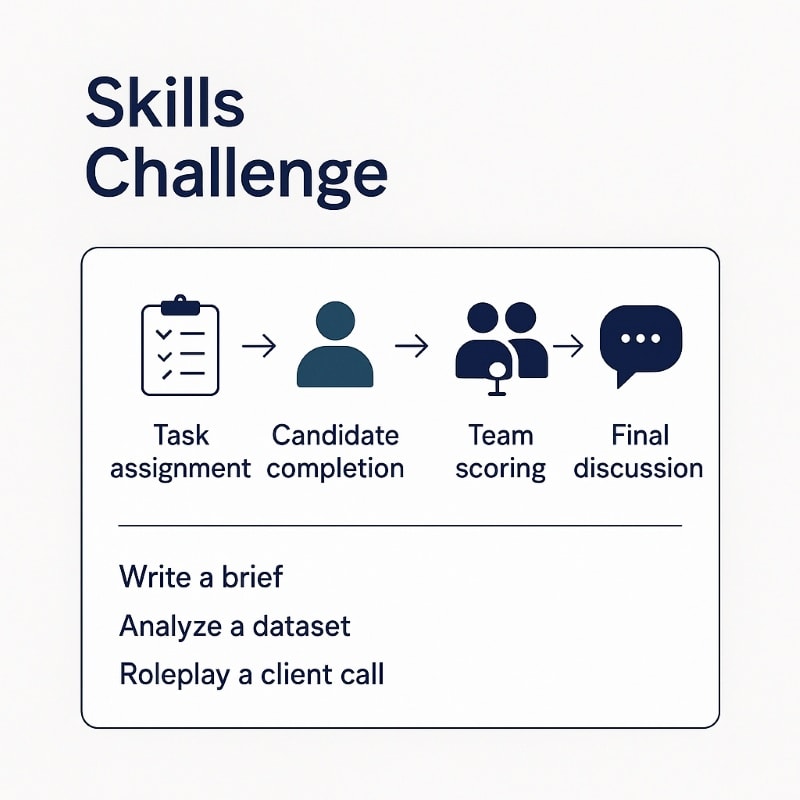
Strategy 6 – Prioritize Cultural Fit Without Sacrificing Diversity
Hiring for cultural fit is crucial—but it’s also one of the most misunderstood and misapplied concepts in talent acquisition. Company culture shapes your hiring criteria and guides the search for the right fit, ensuring new hires align with your organization’s core values and contribute to its growth.
Too often, “fit” becomes shorthand for “someone I’d enjoy grabbing coffee with.” That’s a fast track to groupthink and missed opportunity. True cultural fit isn’t about shared hobbies or personalities—it’s about alignment with your organization’s mission, values, and work style.
At the same time, you need to be mindful of diversity of thought, background, and experience. Companies that embrace cognitive and cultural diversity consistently outperform those that don’t. According to McKinsey, businesses in the top quartile for ethnic and cultural diversity are 36% more likely to outperform their peers in profitability.
So how do you balance culture fit and inclusion?
- Define your culture clearly. What behaviors are rewarded? What values are non-negotiable? Put these in writing.
- Use team-based interviews. Involve peers from different departments to assess how the candidate collaborates across the org chart.
- Avoid the “mirror effect.” If everyone on your team thinks the same way, you’re hiring for comfort—not growth.
- Evaluate the right fit for your company culture. Assess whether candidates align not just with the role, but also with your company culture and values.
When done well, cultural fit becomes a force multiplier, enhancing collaboration, retention, and performance—without closing the door to diverse, high-potential talent.
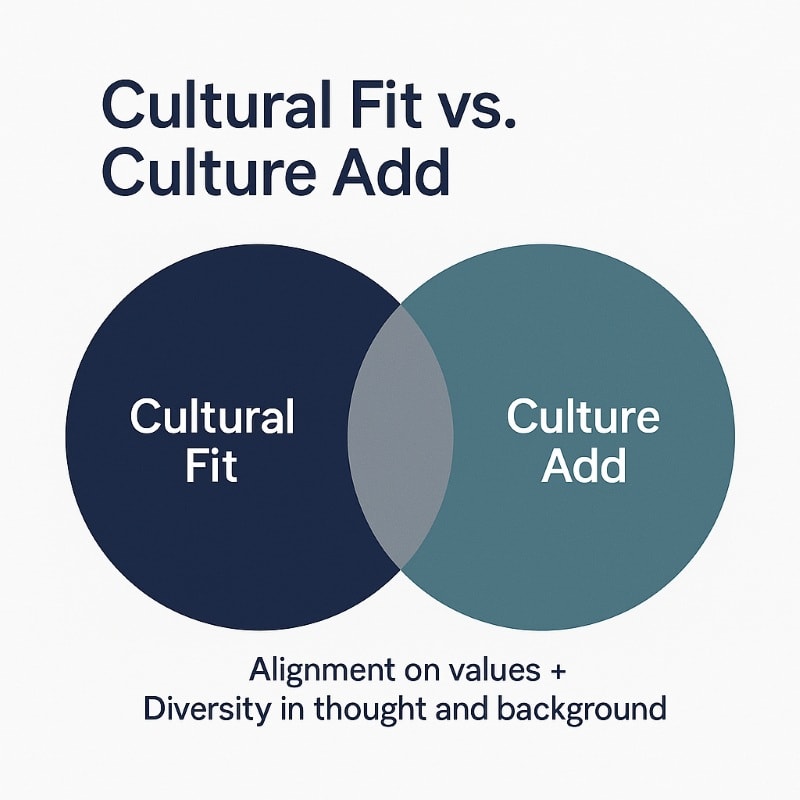
Build Fairness and Compliance Into Every Hiring Decision
A fair, compliant hiring process isn’t just about avoiding legal risk—it’s about building trust with candidates and creating the foundation for a high-performing, inclusive team.
Hiring managers play a central role in this. When they use structured interviews, standardized assessments, and clear job benchmarks, every candidate is evaluated against the same criteria. This consistency doesn’t just reduce bias—it signals to applicants that your process is thoughtful, intentional, and aligned with best practices.
To strengthen fairness further, companies should embed diversity, equity, and inclusion (DEI) principles into each stage of recruitment. That could mean:
- Training hiring teams to recognize and mitigate unconscious bias
- Conducting blind resume reviews during early screening
- Using assessments that focus on job-relevant traits—not just experience or education
Tools like OAD’s behavioral assessments help reinforce objectivity, surfacing candidate potential based on how they’re likely to perform—not just how they present.
Fair hiring is good business. It expands your talent pool, strengthens your employer brand, and contributes to a team culture that values different perspectives. And when fairness is built into your hiring framework, you don’t just hire the right person—you create an environment where the right people want to stay.
Strategy 7 – Build a Talent Pipeline Before You Need It
The best time to look for talent? Before you have an open role.
Too many companies scramble to fill positions only after a key employee leaves or new growth demands arise. This reactive approach leads to rushed decisions, limited candidate pools, and costly mismatches. Instead, smart organizations build a proactive talent pipeline—a pool of pre-qualified candidates who are aligned with your values and ready to step in when the time is right.
Think of it like sales: you wouldn’t wait until revenue dries up to start prospecting. The same applies to hiring. Companies like Salesforce and HubSpot invest heavily in employer branding, community engagement, and ongoing candidate nurturing. Why? Because it keeps top talent within arm’s reach—even when they’re not actively hiring.
To build your pipeline:
- Stay active on LinkedIn and in relevant communities
- Engage passive candidates through content and casual conversations
- Maintain a candidate relationship management (CRM) system to track interest and fit
- Host talent-focused events or webinars to attract future hires
A recruiter plays a crucial role in sourcing and nurturing talent for future roles, ensuring a consistent and structured approach to building your pipeline. Maintaining a strong talent pipeline not only supports your organization’s needs but also helps candidates achieve their career growth and development goals.
OAD clients often use behavioral assessments early in the pipeline to identify potential matches—even if there’s no open position yet. This saves time later and helps build a culture of readiness.
With a well-maintained talent pipeline, you’ll reduce time-to-hire, elevate candidate quality, and stay ahead of your competition when it matters most.
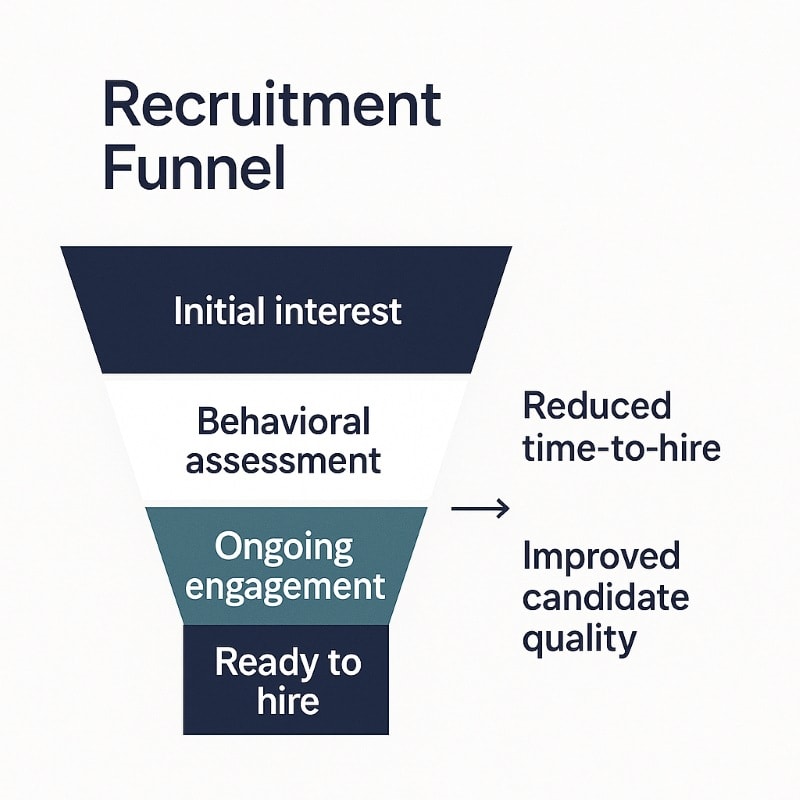
Stay Aligned with Evolving Labor Market Trends
The hiring landscape is shifting faster than ever—and if you’re not tracking labor market data, you’re already behind.
Forward-thinking hiring managers don’t guess what candidates want or assume yesterday’s job requirements still apply. They analyze real-time labor market insights to understand where talent is concentrated, which skills are in demand, and how compensation benchmarks are evolving.
This kind of intelligence transforms hiring from reactive to strategic. For example, if your industry is facing a shortage of data analysts, labor market data might reveal adjacent roles with transferable skills—or regions where that talent is more accessible. That means you can adjust your job descriptions, upskill internal talent, or widen your search before the competition even reacts.
It’s also essential for keeping your offers competitive. With wage expectations and benefit preferences constantly shifting, labor market trends help ensure you’re attracting—not repelling—top-tier candidates.
Smart hiring starts with knowing the environment you’re hiring into. When you pair labor market insights with internal behavioral data, you create a hiring strategy that’s not just informed—but future-proof.
Strategy 8 – Improve the Candidate Experience
In today’s competitive talent market, candidates are evaluating your company just as much as you’re evaluating them. A poor hiring experience can cost you top talent—before you even realize what went wrong.
According to a report by Glassdoor, 58% of candidates say a negative experience makes them less likely to accept a job offer, while 72% share their experience online. That means your interview process isn’t just internal—it’s part of your employer brand.
So what defines a great candidate experience?
- Clarity: Clear job descriptions, transparent timelines, and well-defined expectations
- Responsiveness: Timely follow-up and communication throughout the process
- Respect: Efficient interviews that value the candidate’s time and provide meaningful feedback
- Consistency: Structured steps that reflect fairness and professionalism
- Opportunity to talk: Interviews that allow candidates to talk about their experiences and skills, helping them feel heard and respected
When you interview candidates, it’s important to do so in a way that is respectful and structured, ensuring they have the chance to communicate effectively and demonstrate their fit for the role.
It’s not about pampering candidates—it’s about respecting them as professionals. When your hiring process feels thoughtful, organized, and aligned with your company’s values, candidates walk away feeling energized—even if they’re not selected.
OAD clients often embed behavioral insights into their communication process, helping candidates understand why certain traits matter for success in the role. This builds trust and boosts engagement.
Think of your candidate experience as your first cultural handshake—and make it count.
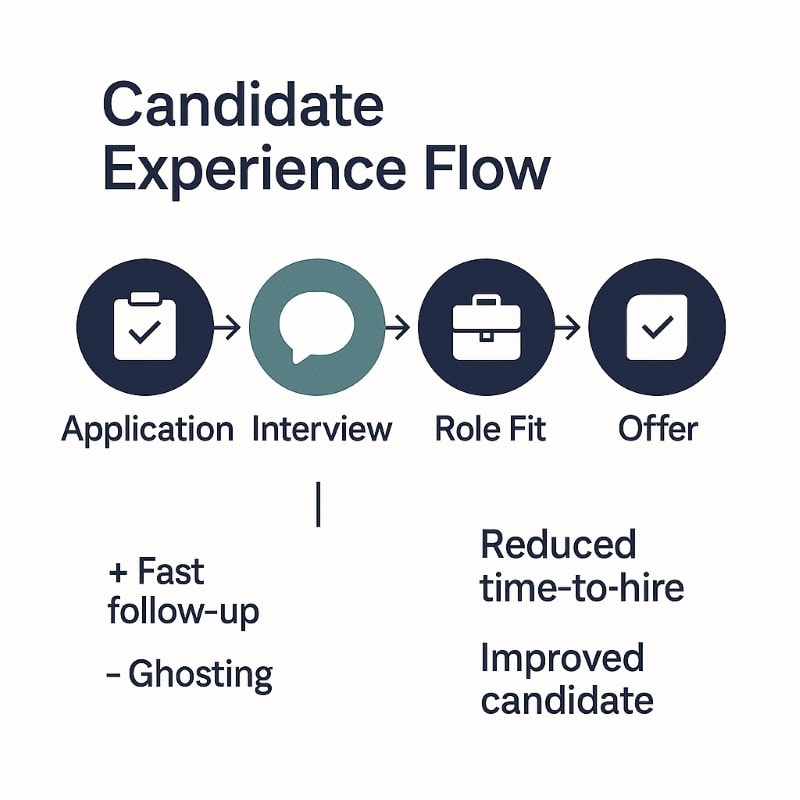
Strategy 9 – Don’t Neglect the Onboarding Process
Hiring doesn’t end when the offer is signed. In fact, some of the most costly mistakes happen after a candidate accepts the job—when onboarding is rushed, unclear, or entirely missing. A well-structured onboarding process helps a new employee feel welcomed and supported from day one, setting the stage for long-term success.
Research from Gallup shows that only 12% of employees strongly agree their company does a great job onboarding. That means nearly 9 out of 10 companies are failing to set new hires up for success.
Great onboarding is more than paperwork and a welcome email. It’s a structured, intentional process that:
- Introduces new hires to your culture and values
- Clarifies role expectations and short-term goals
- Connects them to key people, tools, and workflows
- Builds momentum through early wins
Howard Schultz, during his time at Starbucks, made onboarding a cornerstone of the company’s culture. He believed that how employees feel on Day 1 shapes how they perform for years to come. And he was right: effective onboarding has been linked to higher engagement, faster productivity, and stronger retention.
To do it well:
- Create a 30/60/90-day plan with clear milestones
- Assign mentors or onboarding buddies
- Integrate behavioral insights from assessments into early coaching conversations
By investing just a little more energy upfront, you ensure your hiring decisions actually pay off—not just on paper, but in performance.
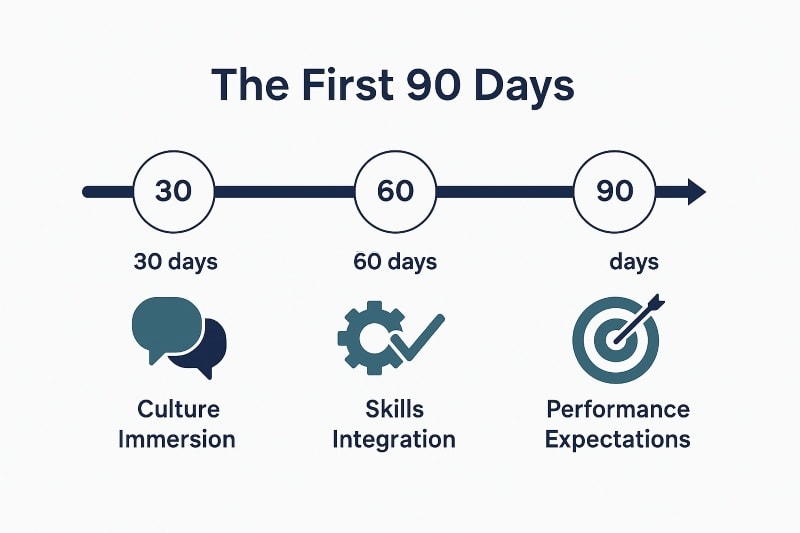
Strategy 10 – Track the Right Hiring Metrics
You can’t improve what you don’t measure. If your hiring process isn’t backed by clear metrics, you’re essentially flying blind—making it hard to know what’s working, what’s not, and where to improve.
The most effective hiring teams treat recruitment like any other high-impact business function: with clear KPIs and a commitment to continuous improvement.
Some of the most valuable metrics include:
- Time-to-hire: How long does it take to move from job posting to offer accepted?
- Quality of hire: Are new hires meeting performance expectations within their first 6–12 months?
- First-year retention rate: Are your hires sticking around—and thriving?
- Candidate experience scores: Are applicants satisfied with your process, regardless of outcome?
OAD’s behavioral assessment platform makes it easier to connect pre-hire data with post-hire outcomes. For example, you can identify patterns—like which traits lead to long-term success in sales vs. operations—and refine your job benchmarks accordingly.
Tracking these metrics not only helps optimize your hiring funnel but also aligns HR with business outcomes. Business owners benefit from monitoring these hiring metrics, as it enables them to make informed decisions that directly impact organizational success. Reviewing these metrics in more detail can uncover hidden trends and opportunities for improvement. Over time, it allows you to spot weak links, double down on what works, and confidently justify strategic hiring investments to the C-suite.
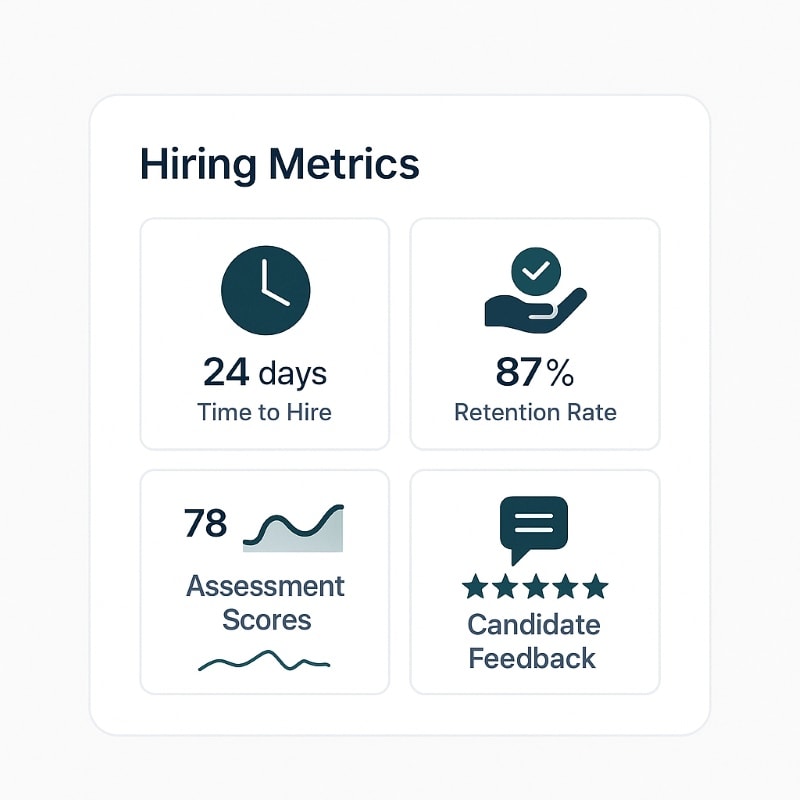
Optimize Your Hiring Process Through Continuous Improvement
World-class hiring systems aren’t built overnight—they’re refined over time. The most effective organizations treat hiring as a living process, constantly learning from performance data, candidate feedback, and team outcomes.
That starts with tracking the right metrics. Time-to-hire, new hire retention, and candidate satisfaction aren’t just vanity stats—they’re early indicators of hiring quality. They reveal where your process is working, where it’s breaking down, and how to improve it without guesswork.
This data can guide strategic decisions:
- Are your job descriptions attracting the right candidates?
- Are your interview questions predictive of on-the-job success?
- Are candidates dropping off at a particular stage?
Gathering input from both candidates and new hires is especially powerful. Their feedback often uncovers friction points—confusing steps, long delays, or unclear expectations—that internal teams may overlook.
Technology can accelerate these improvements. Modern applicant tracking systems, behavioral assessments, and even video-based screening tools can streamline workflows while delivering a better experience for both candidates and hiring teams.
When continuous improvement becomes part of your hiring culture, you don’t just fix problems—you build a process that evolves alongside your business needs. And that positions you to attract, select, and retain the best talent—no matter how the market shifts.
Final Hiring Decisions: Make Them Strategic, Not Emotional
By the final round, you’ve gathered resumes, interview notes, maybe even assessment results. But this is where many hiring teams fall back into emotional decision-making—choosing the most likable candidate, the one with the flashiest background, or the person who “just feels right.” The challenges and considerations involved in reaching the final hiring decision require careful, objective evaluation to ensure the best outcome for your team.
That’s a costly mistake.
Emotional decisions often ignore red flags, overvalue soft impressions, and undercut your structured process. Instead, treat the final decision as a strategic business call—because it is.
Here’s how to do it:
- Revisit your scorecards and data. Let structured inputs carry the most weight to help you decide between candidates objectively.
- Debrief as a team using objective language: “Based on our success profile…”
- Ask: Does this person align with our culture and mission long-term?
- Identify the best candidate by comparing each applicant against structured criteria and assessment results.
- Conduct a reference check with the candidate’s previous employers to gain deeper insight into the candidate’s experience, reputation, and fit before making the final hiring decision.
- Avoid rushing—especially if consensus isn’t clear. It’s better to extend the process than settle. Focusing on just one candidate without thorough comparison can lead to overlooking someone who may be a better fit.
Amazon’s hiring principle is simple: every new hire should “raise the bar.” That standard pushes leaders to be deliberate, not reactive—and it’s a principle any company can adopt, no matter the size.
With behavioral insights from tools like OAD, you’re not just trusting your instincts—you’re confirming them with data. That’s how you consistently hire people who thrive, contribute, and stay.

Case Study: From Chaos to Clarity – A Mid-Market Company’s Turnaround
When a mid-market logistics firm with 200 employees came to OAD, their hiring process was in disarray. They were growing fast, but employee turnover had spiked to 36% annually. Morale was low, onboarding was inconsistent, and hiring managers couldn’t agree on what “the right candidate” looked like.
Here’s what we uncovered:
- Job descriptions were vague, listing tasks but not behavioral expectations
- Interviews were inconsistent—no scorecards, no structured questions
- Final decisions were made based on gut feel and “culture fit,” with no shared definition of what that meant
The result? High-performing candidates were slipping through the cracks, while poor fits were repeatedly hired—and quickly exited.
OAD stepped in with a full hiring audit. We helped the company:
- Build behavioral success profiles for their most critical roles
- Implement structured interviews and scoring systems
- Train hiring managers to use behavioral data as a decision-making tool
- Benchmark candidates against proven success traits using OAD assessments
The outcome was fast and measurable:
- Turnover dropped from 36% to 18% within 9 months
- New hires reached productivity benchmarks 27% faster
- Hiring managers reported higher confidence and alignment across the board
This structured approach creates a more cohesive and high-performing team by aligning everyone around clear expectations and shared values. Improved onboarding and hiring processes also support employee career development, leading to greater long-term engagement and satisfaction.
Today, hiring is no longer a pain point—it’s a competitive strength. And it all started by shifting from opinion-based decisions to a data-backed, behavioral approach.
Final Thoughts – Strategic Hiring Powers Growth
Hiring isn’t just an HR function—it’s a growth strategy.
Every person you bring into your organization influences your culture, productivity, and ability to scale. When you rely on outdated methods, gut feelings, or guesswork, you put that growth at risk. But when you combine behavioral science, structured processes, and the right tools, you set your team—and your business—up to thrive.
Better hiring decisions aren’t about luck. They’re about clarity, alignment, and consistency.
If you’re ready to elevate your hiring process, reduce costly turnover, and bring in candidates who actually stick and succeed—OAD can help.
Smarter Hiring Starts Here
See how leading companies are using OAD’s behavioral assessments and data-backed tools to turn hiring into a competitive advantage.
Test OAD for free today and start making every hire count.
